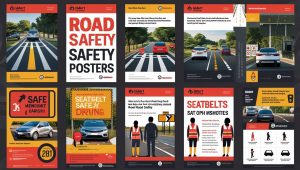Safety Network Traffic Signs: Organizing Roads Efficiently
Proper road organization is crucial for reducing accidents, improving traffic flow, and ensuring the safety of drivers and pedestrians. Safety network traffic signs play a vital role in achieving these goals. They guide road users, provide crucial information, and help maintain order on highways, urban streets, and intersections.
Hubert Ebner India emphasizes the importance of designing and implementing a comprehensive network of traffic signs to create safer and more efficient roads for everyone.
Understanding the Role of Safety Network Traffic Signs
Safety network traffic signs are more than just symbols on the road. They are essential tools that communicate rules, hazards, and directions to drivers and pedestrians.
Key functions include:
- Guidance for Drivers – Signs inform drivers about directions, lanes, speed limits, and exits.
- Hazard Warnings – Alerts about curves, intersections, pedestrian crossings, and road conditions.
- Traffic Control – Signals, stop signs, and yield signs regulate traffic flow and prevent accidents.
By implementing a well-designed safety network traffic signs system, municipalities can ensure that roads remain organized and safe for all users.
Benefits of a Well-Designed Safety Network Traffic Signs System
A systematic approach to traffic signage offers multiple advantages:
- Improved Road Safety – Clear signs reduce confusion and prevent collisions.
- Enhanced Traffic Flow – Drivers make better decisions, reducing congestion.
- Consistency Across Regions – Standardized signs ensure that drivers recognize and understand rules wherever they travel.
Properly designed safety network traffic signs also support automated systems, GPS navigation, and driver-assistance technologies, further enhancing road safety.
Designing an Effective Traffic Sign Network
The effectiveness of traffic signs depends on careful planning and strategic placement. Consider the following elements:
- Visibility and Placement – Signs should be visible from a safe distance, placed at the right height and angle.
- Clarity of Information – Use standardized symbols and concise wording for quick comprehension.
- Maintenance and Updates – Regular inspection ensures that signs are legible, clean, and functional.
Hubert Ebner India provides solutions and expertise in designing a safety network traffic signs system that is reliable, durable, and user-friendly.
Integrating Technology with Traffic Signs
Modern traffic management combines traditional signage with advanced technology:
- Digital Displays and LED Signs – Offer real-time updates about traffic conditions, accidents, or detours.
- Smart Road Systems – Sensors and cameras can alert drivers and authorities about hazards.
- Interactive Mapping and GPS Integration – Ensures drivers receive accurate guidance aligned with physical traffic signs.
By integrating technology, a safety network traffic signs system becomes more efficient, adaptive, and capable of improving overall road safety.
Community and Authority Collaboration
A successful traffic sign network requires cooperation between local authorities, traffic engineers, and communities:
- Traffic Audits and Safety Assessments – Identify high-risk areas and design signage accordingly.
- Public Awareness Programs – Educate drivers on the meaning and importance of different signs.
- Feedback Mechanisms – Communities can report damaged or unclear signs to ensure continuous improvement.
Such collaboration ensures that the safety network traffic signs remain effective, relevant, and aligned with real-world traffic needs.
Conclusion: Safer, Smarter, and More Organized Roads
A well-planned and maintained system of safety network traffic signs is critical for organizing roads efficiently. By guiding drivers, warning about hazards, and regulating traffic, these signs play a central role in preventing accidents and promoting smoother travel.
Hubert Ebner India supports initiatives that implement, maintain, and innovate traffic sign networks. Investing in a robust signage system not only enhances safety but also builds smarter, more efficient roads that benefit everyone.




